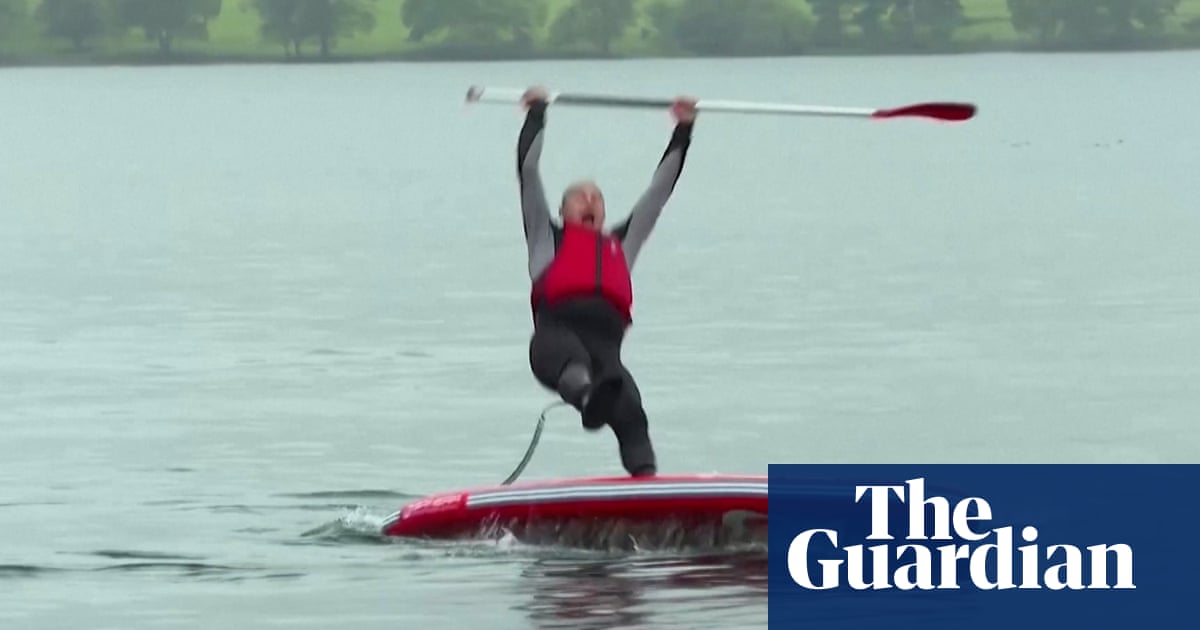
The Liberal Democrats have used their first election broadcast of the campaign to show Ed Davey in a highly personal light, part of a focused and targeted approach that the party hopes could win them close to 50 seats.
The broadcast includes footage of Davey at home as he looks after his teenage son, John, who is disabled, in part to highlight the work of carers but also to try to introduce the Lib Dem leader to voters who might know little or nothing about him.
Davey has already pushed his way on to TV election bulletins with a series of visual stunts, including falling off a paddleboard, going on a waterslide, and cycling down a steep hill.
The election broadcast, which comes after an ITV interview in which Davey talked about the early death of his parents and his worries about who will care for John in the future, is intended to introduce him to voters in dozens of seats where the Lib Dems hope to unseat Conservative MPs.
Davey told the Guardian that the decision to allow himself to be filmed at home and with his son followed a “long chat” with his wife, Emily, and was intended to help highlight the issues faced by carers.
“It’s not always been comfortable, talking about that, but it’s a serious message,” he said. “It’s just telling my story and hoping – because there are millions of people like me – that I can bring the caring issue out of the shadows. It’s been in the shadows for far too long.”
The visual stunts, he added, were tied to a policy pledge, for example sewage with the paddleboarding: “We’re making serious points, and the election is a serious matter. But I think you can do it in a slightly fun way.”
After a disastrous 2019 election in which the party won 11.5% of the vote but just 11 seats, the Lib Dems have switched to a disciplined and pinpointed system in which almost all resources are used in a few dozen target constituencies.
While the party refuses to say how many there are, the Guardian understands that it is about 50 seats, each of which had at least 40,000 leaflets delivered in the first week of the campaign alone.
Many of these are in the “blue wall” Conservative-held commuter belt areas where the Lib Dems have already won byelections, with others located in the party’s traditional heartland of south-west England.
A number of formerly ultra-safe Tory strongholds are vulnerable, including the Surrey Heath constituency vacated by Michael Gove, what was Greg Clark’s seat of Tunbridge Wells, and potentially Godalming and Ash, the newly created seat being fought by Jeremy Hunt.
A key part of the barrage of Lib Dem leaflets and door-knocking in these areas will be to persuade younger residents who usually support Labour or the Greens to vote tactically to help oust a Tory MP, party officials say.
“The tactical voting in a lot of these blue wall and historically Lib Dem seats is going to be absolutely critical,” one Lib Dem official said. “Some of these younger voters have moved from cities relatively recently and might not know that we the challengers to the Tories locally. If we can get the message out to them, lots of Conservative seats could fall.”
The party is also heavily targeting centrist Conservative voters, particularly in blue-wall seats, with officials labelling one target group as “Woking Waitrose Woman”.
While there are obvious worries about hubris after 2019, when the then-leader Jo Swinson started the campaign predicting she could become prime minister, this week’s YouGov mega-poll predicted a return of 48 Lib Dem MPs on just 8% of the vote share.
Davey said things were looking good: “Compared to anything else I have ever seen before, in the seats we are targeting, the Tory vote is crumbling.”











